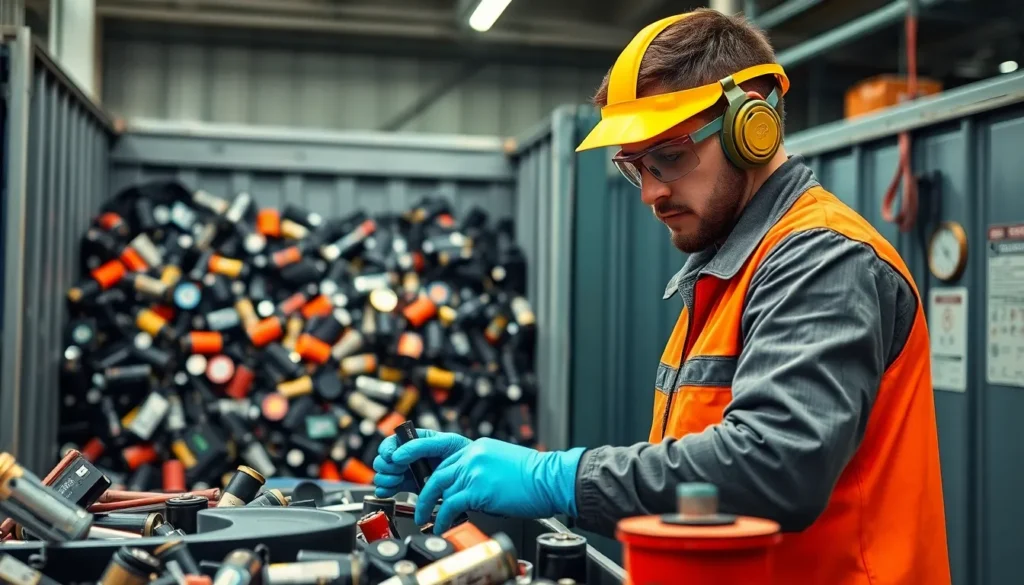Batteries power the gadgets that keep our lives buzzing, but what happens when they run out of juice? Tossing them in the trash might seem easy, but it’s like throwing a party and forgetting to clean up afterward. Enter battery recycling processes, the unsung heroes of the eco-friendly world. They swoop in to save the day, ensuring that those little power packs don’t end up poisoning our planet.
Recycling batteries not only conserves valuable resources but also reduces harmful waste. It’s a win-win situation where Mother Nature gives a thumbs-up while you can feel like a sustainability superstar. So, let’s dive into the fascinating world of battery recycling processes and discover how these methods transform dead batteries into something useful, all while keeping our environment safe and sound. Who knew saving the planet could be so electrifying?
Table of Contents
ToggleOverview of Battery Recycling Processes
Battery recycling involves several critical steps designed to efficiently recover valuable materials and minimize environmental impact. Collection marks the first stage, where used batteries are gathered from various sources such as retail stores, recycling centers, and residential drop-off locations. These collection points play a significant role in ensuring proper disposal.
Next, sorting takes place to categorize batteries based on their chemistry. Common types include lead-acid, lithium-ion, nickel-cadmium, and others. Each battery type requires specialized processing techniques to maximize material recovery and maintain safety.
Shredding follows sorting, breaking batteries into smaller pieces. Once shredded, materials undergo further separation. Metals, plastics, and electrolytes are extracted using advanced separation technologies like magnetic and hydrodynamic methods. Recovery rates for metals like cobalt, nickel, and lithium can reach up to 95%, demonstrating the effectiveness of these processes.
After separation, the recovered materials undergo refining. This step purifies the metals and prepares them for reuse in manufacturing new batteries or other products. The refined materials contribute significantly to reducing the demand for virgin resources.
Finally, safe disposal of non-recyclable components occurs. Hazardous materials are treated according to stringent regulations, minimizing environmental risk. Through these detailed processes, battery recycling successfully transforms waste into valuable resources, supporting sustainability efforts and conserving natural resources. Each step contributes to a comprehensive system designed to support a circular economy.
Importance of Battery Recycling

Battery recycling plays a vital role in environmental conservation and resource management. Engaging in recycling practices benefits both ecosystems and economies.
Environmental Impact
Environmental risks arise when batteries are improperly disposed of. Toxic materials such as lead and cadmium can contaminate soil and groundwater. Recycling addresses these issues by safely processing hazardous components, significantly reducing pollution levels. Notably, recovering metals through recycling decreases the need for mining, which often results in habitat destruction and increased carbon emissions. By transforming waste into reusable materials, battery recycling supports a cleaner planet and fosters sustainable practices.
Economic Benefits
Battery recycling contributes positively to the economy. It creates jobs in sectors like collection, processing, and distribution. Moreover, recycling conserves valuable resources such as lithium, cobalt, and nickel, driving down production costs for manufacturers. Reports indicate that the battery recycling market is expected to grow substantially, providing further economic opportunities. By prioritizing recycled materials, industries lower their reliance on virgin resources, promoting a circular economy that benefits both businesses and communities.
Types of Batteries Recycled
Battery recycling includes various battery types, each with unique characteristics and recycling processes. Understanding these types is crucial for effective recycling and resource recovery.
Lead-Acid Batteries
Lead-acid batteries dominate the recycling industry due to their widespread use in vehicles. Approximately 97% of these batteries get recycled, making them one of the most effectively managed types. During recycling, lead and sulfuric acid undergo treatment processes. Recovered lead can be reused in new batteries, while the acid gets neutralized or converted into sodium sulfate, a useful powder in laundry detergents.
Lithium-Ion Batteries
Lithium-ion batteries are increasingly common in consumer electronics, electric vehicles, and renewable energy applications. Their recycling poses complex challenges due to diverse chemistries, yet advanced technologies handle these hurdles effectively. Methods like mechanical separation and pyrometallurgical processes extract valuable materials, including lithium, cobalt, and nickel. With recovery rates reaching up to 95%, lithium-ion battery recycling significantly reduces reliance on mining and helps conserve resources.
Other Battery Types
Various other battery types, such as nickel-cadmium and nickel-metal hydride, also play important roles in recycling. Nickel-cadmium batteries require careful handling due to cadmium’s toxicity. Specialized recycling processes safely recover nickel and cadmium for reuse. Nickel-metal hydride batteries, often used in hybrid vehicles, undergo similar methods. Recovery processes yield essential materials that manufacturers can repurpose in new products, fostering sustainability across the industry.
Steps Involved in Battery Recycling
The battery recycling process consists of several key steps that ensure efficient recovery of materials and proper handling of hazardous components.
Collection and Transportation
Collection starts at various locations such as retail stores and recycling centers. Used batteries are collected from consumers and businesses alike. Once collected, logistics come into play as batteries are transported to recycling facilities. Specialty vehicles and containers ensure safe transport, minimizing risks associated with battery leakage or damage.
Dismantling and Sorting
Dismantling occurs upon arrival at the recycling facility. Here, batteries are carefully disassembled to separate components. Sorting follows, categorizing batteries by chemistry types, like lead-acid or lithium-ion. Each battery type requires distinct processing techniques, which enhances efficiency in recovery efforts and reduces contamination during recycling.
Material Recovery
Material recovery represents a critical phase in battery recycling. Shredding machines break down batteries into smaller fragments. Advanced separation technologies extract valuable metals such as cobalt, nickel, and lithium from the mixture. With recovery rates reaching up to 95%, this process significantly contributes to resource conservation, allowing the recovered materials to be refined for reuse in manufacturing.
Challenges in Battery Recycling
Battery recycling faces several significant challenges that affect its efficiency and safety. Addressing these challenges is vital for enhancing the effectiveness of recycling efforts.
Safety Concerns
Safety risks associated with battery recycling warrant careful attention. Hazardous components within batteries can lead to toxic exposure during the dismantling and processing stages. Toxic materials, such as lead and acid, pose health risks to workers involved in recycling operations. Proper training and protective equipment are essential to mitigate these hazards. Unexpected leaks or explosions from damaged batteries can also occur, making facility design and operational protocols critical. Implementing strict safety measures can prevent accidents, ensuring a safer working environment while promoting effective recycling practices.
Technological Limitations
Technological limitations impede the efficiency of battery recycling processes. Current recycling methods often struggle with the complex chemistry of lithium-ion batteries, which vary widely in design and composition. Specialized techniques are necessary for effectively recovering valuable materials such as lithium, cobalt, and nickel. Limitations in existing technologies can result in lower recovery rates, sometimes below 30% for some battery types. New approaches, including advanced separation technologies and innovations in battery design, are essential to overcome these obstacles. Investing in research and development supports the progression toward more efficient and sustainable recycling solutions.
Battery recycling stands as a critical component in the pursuit of environmental sustainability. By transforming used batteries into valuable resources, it not only conserves essential materials but also safeguards the planet from hazardous waste. The intricate processes involved in battery recycling highlight the importance of responsible disposal and the potential for economic growth within this sector.
As technology advances and recycling methods improve, the industry will likely see enhanced recovery rates and reduced risks. Engaging in battery recycling isn’t just a personal choice; it’s a collective responsibility that supports a healthier environment and a thriving circular economy. Embracing these practices today paves the way for a more sustainable tomorrow.





